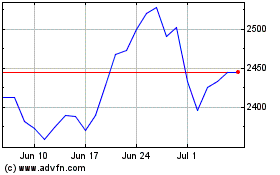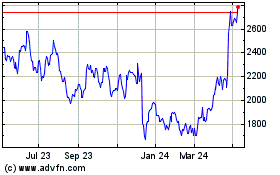De Beers Harvests Diamonds at the Bottom of the Sea
October 20 2016 - 10:56AM
Dow Jones News
By Alexandra Wexler
ORANJEMUND, Namibia -- A dozen miles off the southwestern edge
of Africa's Atlantic coast, a 285-ton vacuum machine operating 400
feet below sea level is sucking some of the world's most valuable
diamonds from the ocean floor.
The $10 million crawler is part of a one-of-a-kind
marine-diamond mining operation dubbed Debmarine Namibia. A joint
venture between De Beers, a unit of Anglo American PLC, and the
government of this sparsely populated desert nation, the marine
mine has emerged as a rare revenue driver in today's languishing
commodities markets.
Remote and secretive, the operation is only reachable by a
30-minute helicopter ride from sleepy Oranjemund, a town built by
the diamond-mining industry to house workers and their families in
the Sperrgebiet, or Forbidden Area, where diamonds were once mined
from the sand dunes by the shovel-full.
Parent Anglo American is cutting costs, unloading most of its
assets and more than half of its employees. But De Beers -- which
accounted for 42% of Anglo's earnings before interest and taxes in
the first half of 2016 -- is pouring money into its increasingly
lucrative marine-mining operation that is yielding some of the
world's highest-quality diamonds.Operations such as Debmarine
highlight how the impending closure of older mines and a looming
global diamond shortage are forcing miners to explore new
technologies and reserves.
"We've not taken the foot off the gas on any [Debmarine]
investment," says Bruce Cleaver, De Beers's chief executive.
Exhibit A in Debmarine's submarine expansion is the SS Nujoma, a
2.3 billion Namibian dollar ($166 million) custom-built exploration
and sampling ship, which arrived in Cape Town from Norway in
August. De Beers says the ship will almost double the number of
seafloor samples unearthed daily.
The company has a total of five production vessels: the Mafuta,
which mines with the crawler, and four ships that mine by drill.
The drills only go down about a foot and a half, as the diamonds
are scattered on the seabed just below the top layer of gravel
rather than embedded in it.
Because there is little disturbance, the company says the
environmental impact is small compared with land-based mining.
"We don't turn up kilometers and kilometers and kilometers of
area in the sea. Our seabeds do recover -- it's not total
destruction," said Jan Nel, operations manager for Debmarine. "We
don't use any chemicals and put all the materials back, except the
diamonds."
Others have more questions about the practice and its effects on
a relatively unexplored ecosystem. "There's not much known about
the impact of these techniques," said Emily Jeffers, a staff
attorney for the Center for Biological Diversity. "We know more
about the surface of the moon than we do about the bottom of the
ocean."
The Debmarine vessels borrow technology from many different
industries -- from oil drilling to fruit canning -- to create a
unique system of marine-diamond mining. Aboard the vessels are
diamond-recovery plants almost identical to those on land, which
mill the seabed rock with steel balls. For each 180 tons milled,
almost a handful of diamonds are recovered.
That happens in the high-security recovery room, where diamonds
and other stones fall into X-ray machines, sounding much like coins
dropping into the tray of a Las Vegas slot machine. Cameras are
ubiquitous and vetted employees must pass through card and
fingerprint readers to gain entry and are rigorously searched on
the way out.
The diamonds are finally poured into what is a soup can-like
container and sealed, then placed in a vault. A helicopter comes a
few times a week to fly the diamonds to Windhoek, Namibia's
capital, for sorting.
Although the seabed diamonds account for just 4% of De Beers's
annual production, they account for 13% of total value, fetching
the highest price a carat of any of the company's mines -- an
average of about $600 a carat versus about $250 a carat from the
flagship Jwaneng mine in Botswana. Their value stems from their
purity, averaging around 95% gem quality versus about 20% in
Botswana, De Beers's No. 1 source of diamonds.
The marine diamonds are a lucrative revenue stream for De Beers
in Namibia, a country with no known diamond-bearing Kimberlite, the
pipes of lava rock where the stones are usually mined. It also has
been a boon to the local government in terms of tax revenue.
So far De Beers's Namibian operations have mined some 16 million
carats at sea and about 62 million carats on land. Debmarine
believes there is at least the same amount of diamonds at sea.
Debmarine has an exclusive mining license for a nearly 2,300
square-mile offshore area and has mined less than 3% of that area
to date. The group believes that at least a quarter of that area
has diamonds, which should take about 50 years to mine out, Mr. Nel
said.
Write to Alexandra Wexler at alexandra.wexler@wsj.com
(END) Dow Jones Newswires
October 20, 2016 10:41 ET (14:41 GMT)
Copyright (c) 2016 Dow Jones & Company, Inc.
Anglo American (LSE:AAL)
Historical Stock Chart
From Mar 2024 to Apr 2024

Anglo American (LSE:AAL)
Historical Stock Chart
From Apr 2023 to Apr 2024
